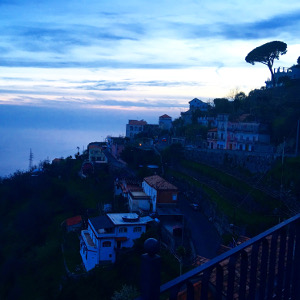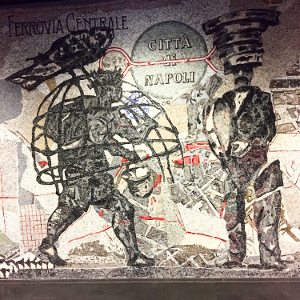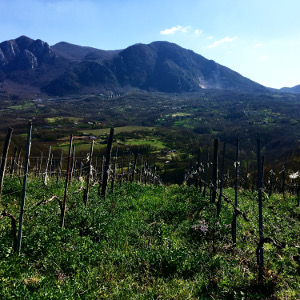Neapolitan Treasures



Delicious, elusive, compelling, frustrating, the wines of Campania have long been among my favorites. This ancient region has been producing marvelous wine since before the foundation of Rome, and there are wines from this region that rank among the best produced in all of Italy. They are less well-known abroad, perhaps, since they are produced from indigenous varieties. Some of these, such as Fiano and Greco among the whites, and Aglianico among the reds are becoming more well-known. Savvy wine lovers, however, will want to explore the full range, as they offer thrilling tastes and flavors, and often provide extraordinary value for money.
This being said, such a quest is often complicated by limited availability. Having tasted several hundred wines from Campania last week, I was frustrated by the limited availability of the top wines. Although this is undeniably true (and perhaps understandable), there were a number of interesting wines that are available – at least online, if not at your local store. I rated a number of the wines last week as either very good (***) or outstanding (****). Here are a few notes on those one might find:
White wines
Fiano
Fiano is a white wine grape widely planted in the area around Avellino. Although the impression of southern Italy and Campania generally is probably one of sunshine and heat, the truth is that Avellino is at a high enough elevation to make it a great spot for the production of white wine. In fact, there is slightly more white made in Campania than red. Fiano is a great place to start. One of my favorite producers is I Favati, who produce an impressive range, and the Fiano (which they call Pietramara) is widely available here. Unfortunately one does not see the reserve-level “Etichetta Bianca” bottling here, but perhaps in time they will arrive. The 2012 white label was my top Fiano of the blind tasting. With a few years of age the 2012 showed a very pleasant evolution. Although there are definitely mature secondary aromas, there is still an impressive freshness and a delicious leesy, yeasty character. Silky and slightly fat on the palate, this will continue to improve. ****
The Fiano di Avellino “Tognano” from Rocca del Principe is from the cooler 2014 vintage is also exemplary, showing a nuanced, delicate nose with notes of hazelnut, ripe apricot, mineral and hay. There is a solid texture and good length. *** Another small producer from the Avellino district is Villa Diamante. Their more youthful bottling, the 2015 Vigna della Congregazione was marvelous, with the ripe apricot fruit with an almost honeyed edge and subtle earth/straw/savory notes as well. This product of the warm ’15 harvest manages elegance and charm with plenty of finesse. The texture is tender and dense with a pleasantly lingering finish. ***
Fortunately, Fiano isn’t strictly limited to Avellino. There is some produced in the fairly obscure Paestum IGP in the southern part of the province of Salerno. San Salvatore 1988 was one of my favorite producers of both red and white wines, and their 2016 Fiano Trentenare showed a very youthful nose with predominantly floral aromas and notes of citrus and spice. The wine was elegant, silky and balanced, with a round, slightly fat feel on the palate, rich and satisfying. ***
Greco
Greco is a grape variety often associated with the soil type (Tufo) in which it is most often planted. I tasted a number of interesting Greco wines and fortunately quite a few are available in the US.
One of the standouts was the 2016 “Serum” from I Capitani, which showed a lovely, expressive nose, slightly restrained at first, but very elegant and nuanced, with a good complexity of orange and grapefruit aromas and a bit of peppery spice with a minty edge. On the palate the wine was well balanced, pleasantly fresh and long. ****
Another Greco with an outstanding score was the 2016 Colle Serrone from Di Marzo, which would reward the efforts that might be required to track it down. The wine was very expressive, with an herbal touch to a fruit that ranges from fresh lemon to apricot and tropical notes. The texture is silky and the lingering finish invites a second glass. ****
There was also a very impressive older vintage on offer in Naples – the 2007 “Vittorio” from Di Meo. Younger vintages are available here, and to judge from the way this wine showed some cellar time is certainly warranted. The aging gave it something of the allure of an “orange” wine without the oxidation or the deep color, but with similar aromas of fresh straw, candle wax and white truffle. The creamy texture testified to copious levels of extract that led the wine to a truly superb finish. Classic, elegant and very subtle. ****
Falanghina
Falanghina is another interesting white from Campania that has been coming back into the spotlight in recent years. The grape is thought to have been the source of one type of the famous Roman wine Falernum, and it is still grown in the Monte Massico where the Roman Falernum was produced (along with Aglianico). It is more widely grown in the Sannio subregion of Beneveneto, where the limestone and marl soils, fairly high elevations (400 – 600 meters), and cooler climate allow the grapes to ripen fully while retaining structure and bright fruit. The 2016 Falanghina del Sannio Svelato from Terre Stregate (“bewitched earth”) shows fairly pronounced aromas of citrus and stone fruit with a touch of honey and a minty edge. Nice ripeness and elegant balance. ***.
Volcanic terroirs can also produce superb Falanghina. The 2016 Falanghina “Verso” from organic producer Sorrentino is also grown at altitude, but the vineyards here are located in the foothills of Mount Vesuvius in the shadow of Pompeii. The wine shows a clean, fresh apricot aroma with notes of lemon peel, candle wax, and some earthy complexity. On the palate the texture is dense and almost oily, with a savory saline finish. ***. Another top volcanic terroir producing interesting Falanghina is Campi Flegrei. The Falanghina “Vigna del Pino” 2015 from Agnanum is produced on terraces cut into the volcano of the same name on the Western edge of the city of Naples itself. The wine showed nice almond aromas a ripe apple fruit, with silky texture, pleasant balance and a lovely persistence on the palate. ****
Other white varieties
A number of other grape varieties in Campania could easily fall into the “other white” category, but my search is not meant to highlight the deliberately obscure, unless, of course, it is outstanding. Few would argue in my view that the wines of the Costa d’Amalfi qualify in that regard. In truth, they are not that obscure, as many are based on Falanghina which is now gaining traction in many quarters, including export markets. Here, however, the grape is blended with a number of indigenous varieties. One of the most wonderful white wines of the trip was the 2015 Furore Bianco from Marisa Cuomo. A blend of Falanghina with Biancolella, Ginestra, Pepolla and a number of even more obscure local grapes. Furore differs from the other terroirs on the Amalfi coast in that it is fully exposed to the sea and there is a pronounced saline/savory character that overlays the rich fruit aromas of fresh and dried apricot, hazelnut and fresh hay. There is an edge of spiciness here, but no oak aging, giving the wine a purity that is absolutely compelling. **** While on the Amalfi coast, mention should also be made of the superb wines of Ettore Sammarco, although in spite of their “tre bicchieri” success with the Gambero Rosso are not imported into the U.S. Their white Grotta Piana and the Costa d’Amalfi Rosso Riserva “Selva della Monache” are particular standouts.
Red Wines
Aglianico
Aglianico is the Southern Italian answer to Nebbiolo and Brunello, producing tremendous, age-worthy wines of great nuance, structure, and complexity. The best of these wines are on a par with anything produced in Italy. Having had the good fortune to enjoy examples of all three over a fifty year span, I can personally vouch for their ageability. Aglianico is grown in many parts of Campania, but there are no more emblematic appellations than Taurasi and its little brother Irpina Aglianico. This was created as a DOC in 1970, and elevated to DOCG, Italy’s highest level, in 1993. Vines are planted between 300 – 600 m of elevation in chalk and clay, which contribute to the characteristically tannic structure of the wines.
A good place to start with the exploration of this varietal is with the Campanian powerhouse Feudi di San Gregorio. Located in Sorbo Serpico, the winery was founded in 1986, and today produces 3,000,000 bottles of wine from all varietals in a good year. In spite (or because of) the fact that the scale of viticulture here is so much larger, Feudi produces lovely wines, particularly from Aglianico. I noted their 2012 Irpinia Aglianico as ***, showing mineral, almost petrol notes and a ripe blackberry fruit. Well-managed tannins, a plump body and nice length. The 2012 Taurasi was also delightful, with very well developed plum and cassis fruit with an edge of leather and spice; full bodied; tannins that were rich but not astringent and a lingering finish. *** Their top-of-the-line Taurasi Riserva Piano di Montevergine 2011 was darker and more complex, with blackberry, plum and fig fruit accented by mineral notes. On the palate it was firm but elegant, with slightly grippy tannins yet no unpleasant astringency. ****
Interesting Taurasi from smaller producers include the 2012 from Villa Raiano, worth seeking out in spite of limited availability. The nose shows ripe black plums and spice. Although it is still very youthful and firm on the palate, it will continue to open up with time and should show well for decades. The 2008 Taurasi from Perillo likewise suffers from limited availability, but rewards with a big mouthful of featuring plenty of dark fruit and a lively, tannic freshness on the palate. Drinking at its peak. *** Another very seductive style is produced by Donnachiara, whose 2012 showed clean, bright blackberry fruit with a hint of chocolate. Firm, tannic, still very youthful and pleasant indeed. **** The Riserva unfortunately does not appear to be available in the U.S., but it is even more concentrated and nuanced than the regular bottling.
There is also very interesting Aglianico produced in the Benevento region as Aglianico del Taburno. One delicious example was the Vigna Cataratte Riserva 2009 from Fontanavecchia, showing lovely rich notes of currants and licorice with an undercurrent of dark chocolate. Silky tannins, full body, good length. Very nice just now but mature. **** Decidedly more youthful is the 2014 from Fattoria La Rivolta, showing ripe blackberry fruit with a smoky, burly edge on the nose. On the palate the wine is well-structured and tannic, yet there is a bright, elegant black fruit character that shines through straight to the finish. Structured without being overly firm. *** Among the most balanced and elegant wines from this region is the 2011 “Diomede” from Ocone. Fermented in wood and aged for one year in a blend of new and used casks, this has a fruit character that is bright yet inky dark in character, with notes of fig, plum blackberry and cassis. The palate is structured but not acerbic – there is an elegance and freshness here that is missing in some of the heavier offerings. ***
Among the more innovative producers is Trabucco, who makes a Falerno del Massico called Rapicano from 100% Aglianico (they also make a version from Primitivo). The 2004 vintage tasted at the winery hinted at the heights this grape can attain with a bit of age, with notes of licorice and spice over an exotic black tea aroma with fresh and dried fruit and a lovely truffle-scented evolution. There is a very silky texture and a wonderful, lingering finish. ****
My top rating of the entire week of tasting went to an Aglianico from Paestum. This little-known region is found along the southern coast portion of the province of Salerno. It is named for a town perhaps more well-known at present for its well-preserved Greek temple than it is for wine, but that could be set to change! The IGP Paestum Aglianico “Omaggio a Gillo Dorfles” 2013 from San Salvatore 1988 (also mentioned for their white wine) was absolutely riveting, with lush, ripe blackberry and cassis fruit with a gamey, leathery edge. There is impressive density and concentration here as well as superb length and harmonious balance. *****
Other red wines
The most common “other red” in Campania is often made from the Piedirosso grape, found in a number of appellations throughout the region. It is particularly emblematic, however, of the Amalfi Coast. The Furore Rosso Riserva from Marisa Cuomo is a fabulous example—and available here. A 50/50 blend of Aglianico and Piedirosso, this shows deeply pungent aromas of dark fig and prune fruit with exotic notes of tar and wild herbs with a mineral, almost salty edge, resulting no doubt from the fact that the vineyards of Furore face the sea in one of the most beautiful settings anywhere in the world of wine. This is a wine of lovely complexity, dark and brooding, with concentrated tannic power, and a long, spicy finish. ****
Even further from the beaten path is the Casavecchia grape, grown only in a tiny area called Ponelatone in the center of the Caserta province on the border with Benevento. Please don’t accuse me of being willfully obscure—this is delicious wine! It has been recognized as a separate region only since 2012, and the total production in 2015 of all producers combined was about 3,500 cases. Little of this makes its way to the U.S., but if you’re curious, you may have a chance to find the Terre del Volturno Casavecchia “Cimmarino” from Cantina di Lisandro (***). As with other examples of Casavecchia, there is a vibrant deep color and very firm tannins. This example shows a ripe, expressive cassis fruit with plenty of punch and nice, spicy depth of flavor. Although firm, the tannins are not astringent, and the wine lingers exotically on the palate. Unique and different, and delicious, just like Campania.
Note: complete notes, even on wines not available in the U.S. are uploaded onto the Tasting Notes page
Comments